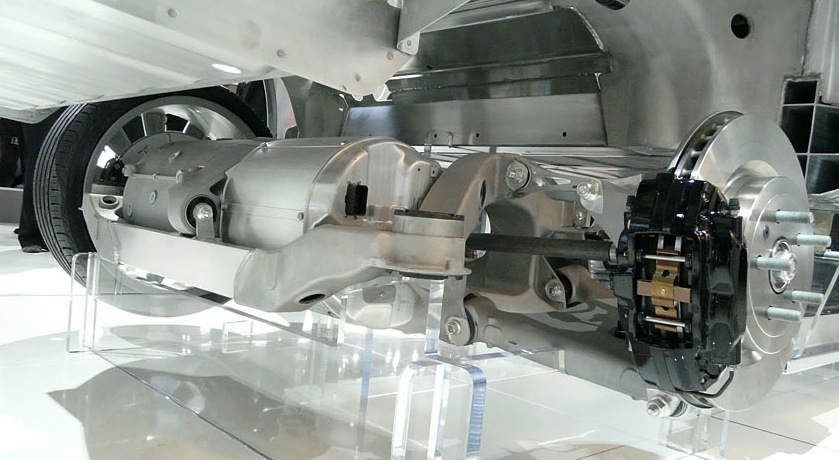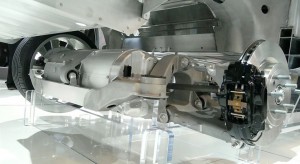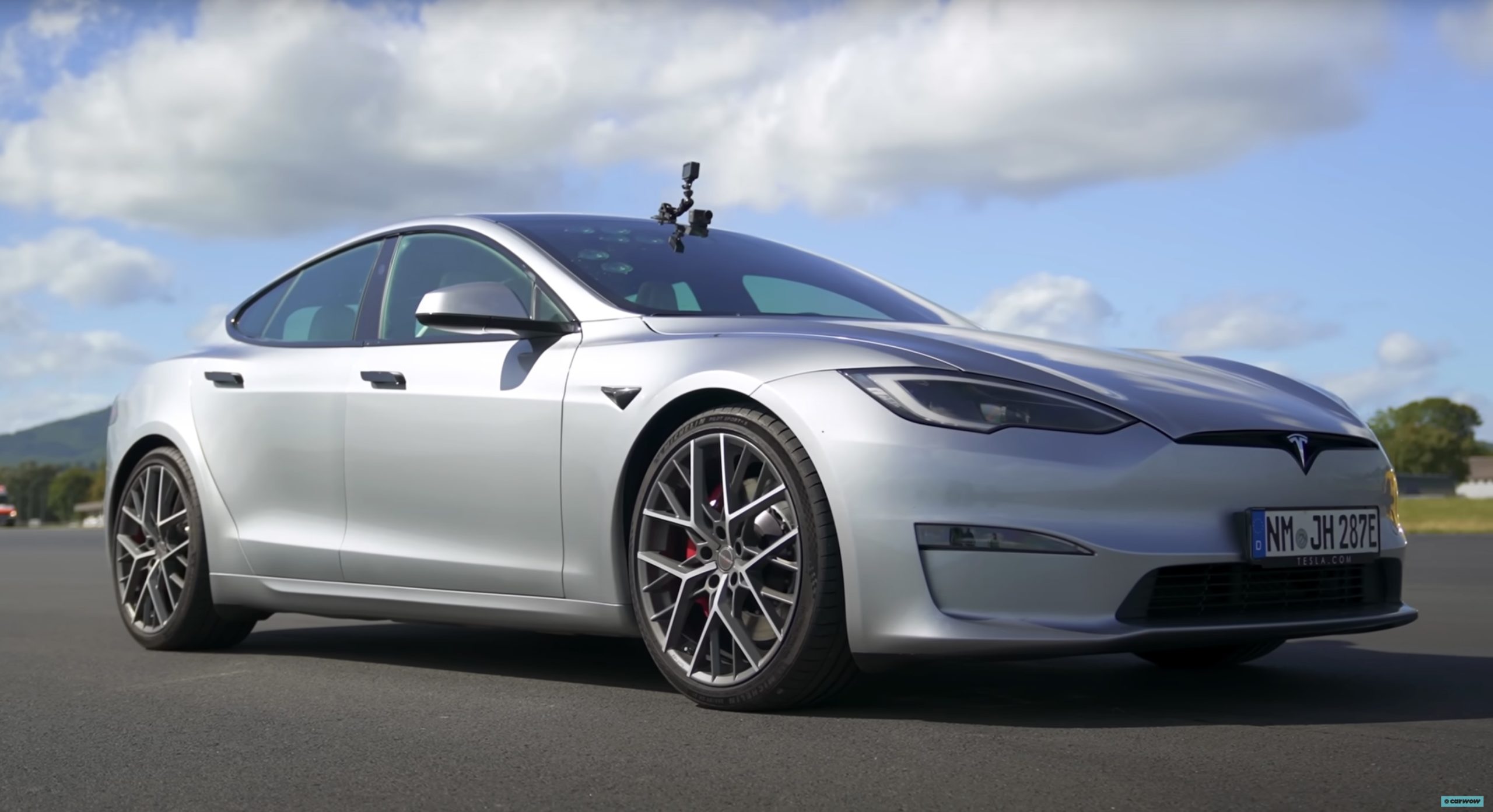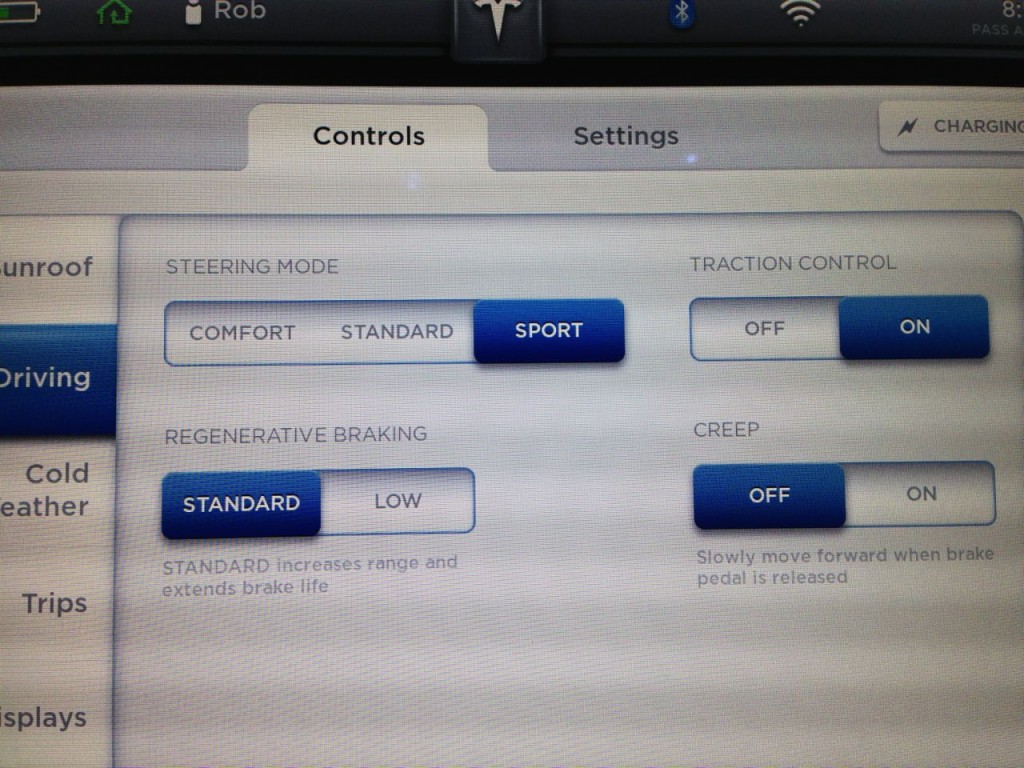Tesla Model S
How does the Tesla Model S Traction Control system work?

I was pulling out of the parking lot at work the other day and happened to experience some wheel spin as I drove over a patch of sand near a construction site. One wheel spun with limited grip while the other wheel pushed me through the slippery patch. The wheel modulation happened automatically and trouble free which led me to think – How does the Model S traction control work?
Before I dive into it all, one caveat: I’m an electrical/software engineer and not a mechanical engineer. I can change a tire, I used to change my own oil many years ago, but otherwise I let a trusted shop (usually a dealer) do all of the work. The information below is based on my own research and opinions.
Open Differential
 I had a very basic knowledge of how the AC induction motor drives the wheels on my Model S. I thought it was just a direct current motor with a positive and negative terminal that spun one way or the other depending on polarity which in turn spun the wheels. This kind of thinking comes from my days dealing with radio control hobby kits coming out of Radio Shack. I hadn’t thought about how that may translate into driving of two wheels, nor how it would handle situations where traction is limited due to sand and ice.
I had a very basic knowledge of how the AC induction motor drives the wheels on my Model S. I thought it was just a direct current motor with a positive and negative terminal that spun one way or the other depending on polarity which in turn spun the wheels. This kind of thinking comes from my days dealing with radio control hobby kits coming out of Radio Shack. I hadn’t thought about how that may translate into driving of two wheels, nor how it would handle situations where traction is limited due to sand and ice.
It turns out, the shaft of the Model S electric motor inserts into an open differential gear box that then drives the two wheels. This gearing allows the outside drive wheel to rotate faster than the inner drive wheel during turns. Without this gearing either the inside wheel will rotate too fast or the outside wheel will drag. Any imbalance may lead to poor handling, damage to your tires and introduce a lot of stress to the drivetrain. HowStuffWorks has great animated images showing how it operates in action.
Tesla describes the gearing as follows (for the Roadster):
“The motor is directly coupled to a single speed gearbox, above the rear axle. The simplicity of a single gear ratio reduces weight and eliminates the need for complicated shifting and clutch work. The elegant motor does not need a complicated reverse gear – the motor simply spins in the opposite direction.”
The downside of the open differential approach is that torque is evenly applied to both wheels. The traction control system limits the maximum amount of torque that can be applied to each wheel without making it slip.
Turning traction control off essentially allows the motor to not back down even when one of the tires is spinning. This can often result in a lot of tire spinning and will not necessarily remove you from being stuck. In fact you may end up digging a deeper hole than the one you’re already in.
Limited Slip
Traditionally a limited slip differential allows for torque to be applied independently of each wheel. This involves complicated gearing which involves more components, adds additional weight and overall may not be as reliable on a Model S that produces such astronomical torque. For that reason Tesla chose to utilize a much simpler and sturdier open differential. But they needed to solve the slip problem.
Tesla solved the problem on the Model S by selectively applying rear brakes in order to transfer torque to the wheel that grips. These commands are fed into the electronic stability control system which is capable of braking the rear wheels independently as a way to improve the handling of the car under various conditions.
Tesla describes both traction and stability control as follows:
“Model S Traction Control is designed to ensure maximum contact between the road and the tires. Whether you are accelerating off the line, zooming along the winding roads of the Rockies or find yourself in a Gulf Coast rainstorm, Traction Control prevents loss of traction and maintains control. Stability Control reacts in moments of under-steer or over-steer by reducing torque and applying the brakes to individual wheels for enhanced control when cornering.”
Summary
Tesla Motors is about disrupting the norm and re-thinking how things should be done. If you start from scratch and question every design decision, every part, every ounce of weight, every approach and leverage the best minds on the planet, what kind of car will you end up with? The Model S is Tesla’s current answer and certainly not their final answer.
Tesla’s traction control and emulated limited slip functionality is another case of Tesla replacing complex and inefficient hardware with something lighter, simpler and more state of the art – augmenting functionality through software and algorithmic science utilizing today’s advanced computing power.
The next time you slam that “go” pedal and take off like a space ship, think about all the technology that’s helping you launch into the future.

News
Tesla shocks with latest Robotaxi testing move
Why Tesla has chosen to use a couple of Model S units must have a reason; the company is calculated in its engineering and data collection efforts, so this is definitely more than “we just felt like giving our drivers a change of scenery.”

Tesla Model S vehicles were spotted performing validation testing with LiDAR rigs in California today, a pretty big switch-up compared to what we are used to seeing on the roads.
Tesla utilizes the Model Y crossover for its Robotaxi fleet. It is adequately sized, the most popular vehicle in its lineup, and is suitable for a wide variety of applications. It provides enough luxury for a single rider, but enough room for several passengers, if needed.
However, the testing has seemingly expanded to one of Tesla’s premium flagship offerings, as the Model S was spotted with the validation equipment that is seen entirely with Model Y vehicles. We have written several articles on Robotaxi testing mules being spotted across the United States, but this is a first:
🚨 Tesla is using Model S vehicles fitted with LiDAR rigs to validate FSD and Robotaxi, differing from the Model Ys that it uses typically
Those Model Y vehicles have been on the East Coast for some time. These Model S cars were spotted in California https://t.co/CN9Bw5Wma8 pic.twitter.com/UE55hx5mdd
— TESLARATI (@Teslarati) December 11, 2025
Why Tesla has chosen to use a couple of Model S units must have a reason; the company is calculated in its engineering and data collection efforts, so this is definitely more than “we just felt like giving our drivers a change of scenery.”
It seems to hint that Tesla could add a premium, more luxury offering to its Robotaxi platform eventually. Think about it: Uber has Uber Black, Lyft has Lyft Black. These vehicles and services are associated with a more premium cost as they combine luxury models with more catered transportation options.
Tesla could be testing the waters here, and it could be thinking of adding the Model S to its fleet of ride-hailing vehicles.
Reluctant to remove the Model S from its production plans completely despite its low volume contributions to the overall mission of transitioning the world to sustainable energy, the flagship sedan has always meant something. CEO Elon Musk referred to it, along with its sibling Model X, as continuing on production lines due to “sentimental reasons.”
However, its purpose might have been expanded to justify keeping it around, and why not? It is a cozy, premium offering, and it would be great for those who want a little more luxury and are willing to pay a few extra dollars.
Of course, none of this is even close to confirmed. However, it is reasonable to speculate that the Model S could be a potential addition to the Robotaxi fleet. It’s capable of all the same things the Model Y is, but with more luxuriousness, and it could be the perfect addition to the futuristic fleet.
News
Tesla Model S makes TIME’s list of Best Inventions

Tesla’s flagship sedan, the Model S, has officially been named one of TIME Magazine’s Best Inventions of the 2000s. It joins its sibling, the Model 3, which made the list in 2017.
The Model S is among the most crucial developments in the automotive industry in the last century.
Just as the Ford Model T made its mark on passenger transportation, becoming the first combustion engine vehicle to be successfully developed and marketed at a time when horse and buggy were the preferred mode of transportation, the Model S revolutionized things a step further.
Although it was not the first EV to be developed, the Tesla Model S was the EV that put EVs on the map. In 2012, TIME recognized the Model S as a piece of technology that could truly transform the car industry.
The publication wrote:
“This electric four-door sedan has the lines of a Jaguar, the ability to zip for 265 miles (426 km) on one charge—that’s the equivalent of 89 m.p.g. (2.6 L/100 km)—and touchscreen controls for everything from GPS navigation to adjusting the suspension.”
Looking back, TIME was right on. The Tesla Model S was truly a marvel for its time, and it, along with the OG 2008 Roadster, can be seen as the first two EVs to push electrification to the mainstream.
As TIME described this year, the Model S “proved to be a game-changing experience for electric vehicles,” and it ended up truly catalyzing things for not only the industry, but Tesla as well.
The Model S acted as a fundraiser of sorts for future vehicles, just as the Model X did. They paved the way for the Model 3 and Model Y to be developed and offered by Tesla at a price point that was more acceptable and accessible to the masses.
The Current State of the Tesla Model S
The Model S contributes to a very small percentage of Tesla sales. The company groups the Model S with the Model X and Cybertruck in its quarterly releases.
Last year, that grouping sold 85,133 total units, a small percentage of the 1.789 million cars it delivered to customers in 2024.
Things looked to be changing for the Model S and the Model X this year, as Tesla teased some improvements to the two cars with a refresh. However, it was very underwhelming and only included very minor changes.
Lucid CEO shades Tesla Model S: “Nothing has changed in 12 years now”
It appeared as if Tesla was planning to sunset the two cars, and while it has not taken that stance yet, it seems more likely that the company will begin taking any potential options to heart.
CEO Elon Musk said a few years ago that the two cars were only produced due to “sentimental reasons.”
Lifestyle
Tesla Model S Plaid battles China’s 1500 hp monster Nurburgring monster, with surprising results
There is just something about Tesla’s tuning and refinement that makes raw specs seem not as game-changing.

The Tesla Model S Plaid has been around for some time. Today, it is no longer the world’s quickest four-door electric sedan, nor is it the most powerful. As per a recent video from motoring YouTube channel Carwow, however, it seems like the Model S Plaid is still more than a match for some of its newer and more powerful rivals.
The monster from China
The Xiaomi SU7 Ultra is nothing short of a monster. Just like the Model S Plaid, it features three motors. It also has 1,548 hp and 1,770 Nm of torque. It’s All Wheel Drive and weighs a hefty 2,360 kg. The vehicle, which costs just about the equivalent of £55,000, has been recorded setting an insane 7:04.957 at the Nurburgring, surpassing the previous record held by the Porsche Taycan Turbo GT.
For all intents and purposes, the Model S Plaid looked outgunned in Carwow’s test. The Model S Plaid is no slouch with its three motors that produce 1,020 hp and 1,420 Nm of torque. It’s also a bit lighter at 2,190 kg despite its larger size. However, as the Carwow host pointed out, the Model S Plaid holds a 7:25.231 record in the Nurburgring. Compared to the Xiaomi SU7 Ultra’s record, the Model S Plaid’s lap time is notably slower.
Real-world tests
As could be seen in Carwow’s drag races, however, Tesla’s tech wizardry with the Model S Plaid is still hard to beat. The two vehicles competed in nine races, and the older Model S Plaid actually beat its newer, more powerful counterpart from China several times. At one point in the race, the Xiaomi SU7 Ultra hit its power limit due to its battery’s temperature, but the Model S Plaid was still going strong.
The Model S Plaid was first teased five years ago, in September 2020 during Tesla’s Battery Day. Since then, cars like the Lucid Air Sapphire and the Xiaomi SU7 Ultra have been released, surpassing its specs. But just like the Model Y ended up being the better all-rounder compared to the BYD Sealion 7 and the MG IM6, there is just something about Tesla’s tuning and refinement that makes raw specs seem not as game-changing.
Check out Carwow’s Model S Plaid vs Xiaomi SU7 drag race video below.









